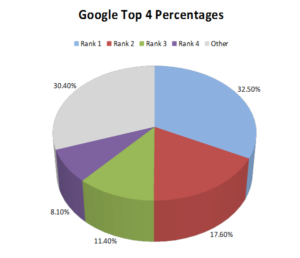In the back of nearly every business owner’s mind is the nagging reality that they should be doing something for an SEO strategy. After all, search engine optimization is nothing new in the technology landscape. While most people know that they should be developing their search presence, many people don’t really understand why. It doesn’t really get translated into numbers, so that is one purpose for this article; another is to purpose gauge the impact of a successful strategy.
SEO Traffic Numbers
As an example, lets say that you are trying to rank for 3 keywords for your insurance agency, because they have good search volumes in Google (numbers at time of writing):
- insurance agency near me – 1,900/month
- local insurance agency – 880/month
- best insurance agency – 480/month
…by the way, to get search volume numbers like these, use this tool below!
Combined, these 3 keywords have 3,260 searches per month. According to Chitika, if you are on the first 4 spots on Google’s organic results, you will get:
- 1st Rank – 32.5% of traffic

- 2nd Rank – 17.6% of traffic
- 3rd Rank – 11.4% of traffic
- 4th Rank – 8.1% of traffic
When you add all of these percentages up, the first 4 results account for nearly 70% (69.6%) of the traffic through Google. It would be incorrect to assume that having a top spot in Google would get you 70% of all traffic, because you would likely only have 1 position. So, to get an average for the amount of traffic, you could get if you were on one of the top 4 spots, lets divide this number in half…34.8%.
Next, lets look at the volume of traffic this would bring to your site, if you were ranking all 3 keywords in the top 4 and assuming this average of 34.8%…that comes to: 1,134 organic site visitors per month.
Increased Lead Generation
While getting great traffic on the website is crucial, next we need to look at lead conversion metrics. Let’s assume that you are getting 20% of your traffic to convert to a lead on the website. At 20%, your 1,134 site visitors would equate an additional roughly 227 leads per month. Using some standard numbers, you should be able to close around 30% of these leads, which is 68 customers. Keep in mind that this metric is taking into consideration a well saturated funnel and pipeline that has leads who have had multiple nurturing touch points.
Boosted Sales
What would your sales team do with 68 additional sales per month? What does that even mean for your business? While it is tempting to just say “68 * [average sale (i.e. $100)] = $6,800.” However, it is important to look at the true value of a lead. A more correct assessment would take into account the average lifetime of a customer, according to your historical customer data. So, if you have an average customer retention of 5 years and assuming that the $100 is on a monthly subscription basis, then your calculation should look like: (68 * $100)60 [months] = $408,000 total over 5 years.
Regardless of whether or not your particular business model is on a subscription basis, the reality is that your business has a lot to gain from getting to the top of Google’s algorithm. While it may seem like a daunting task, it really is not that bad, especially if you have a website that is responsive and is at least more than a year old. Domain age plays a role in SEO ranking, but that doesn’t mean you cannot rank with a fairly new website.







